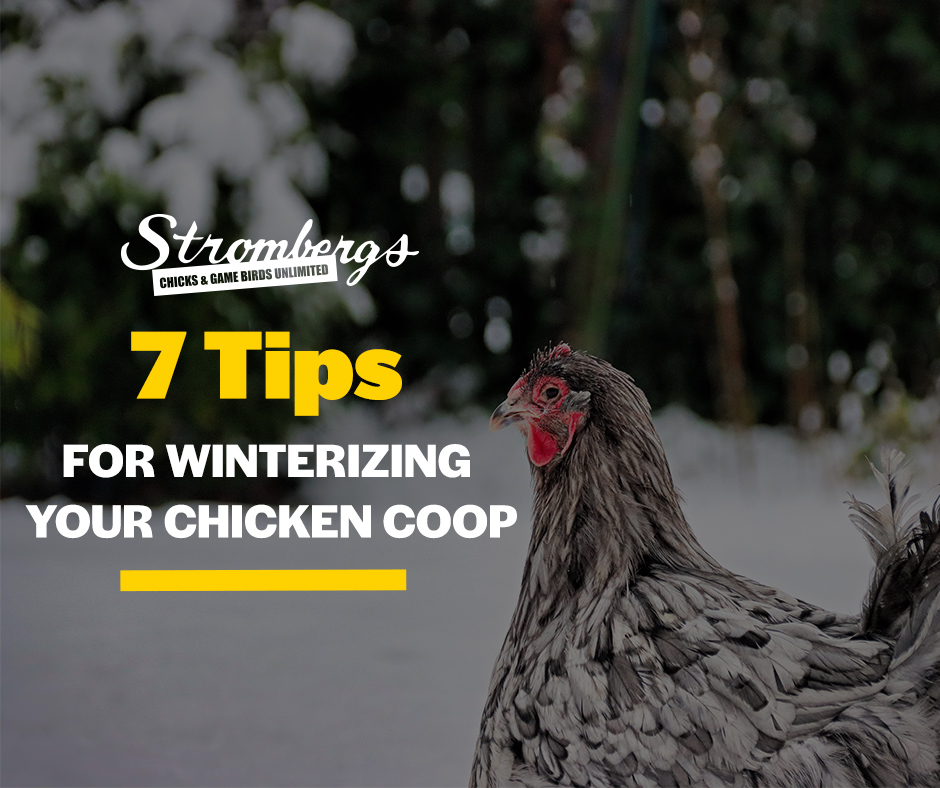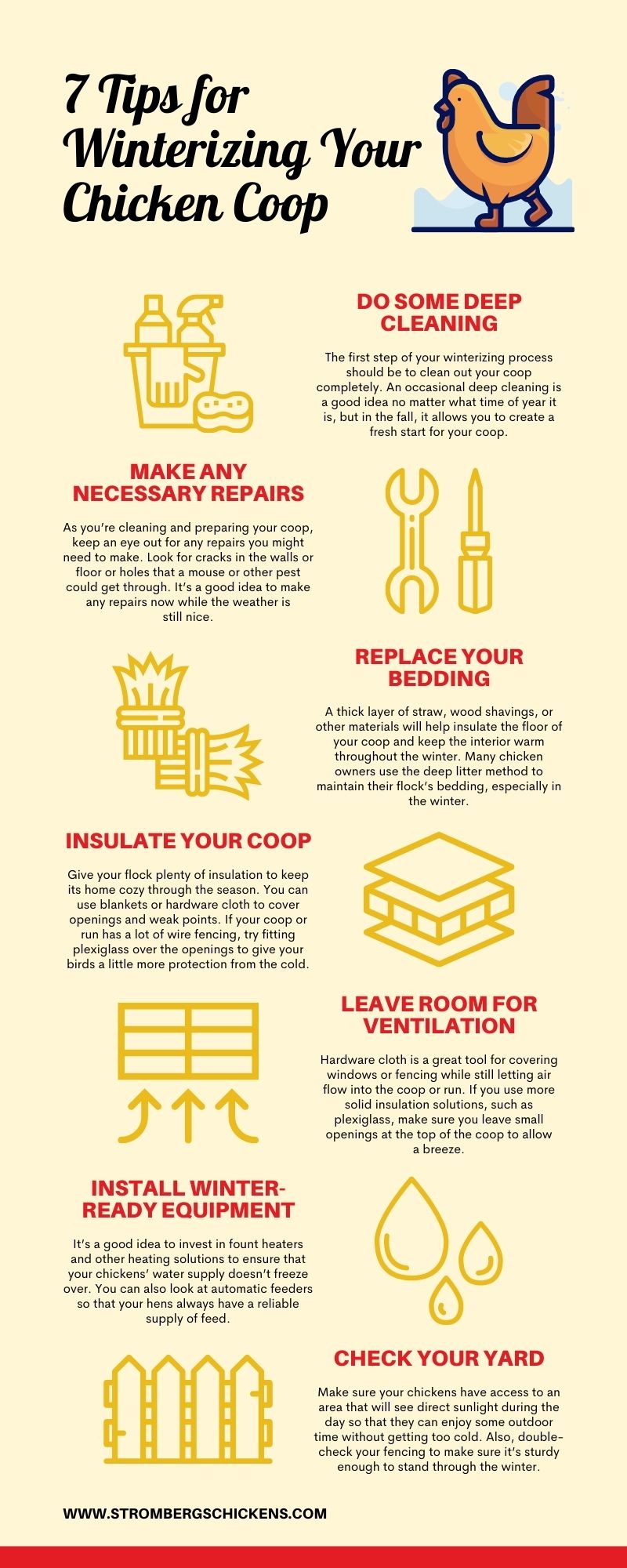7 Tips for Winterizing Your Chicken Coop
When winter comes around, a homeowner needs to make sure everything in their house and yard is ready for the freezing temperatures and potential snowfall. You should do the same for your backyard flock.
While chickens are hardy creatures that do a good job of regulating their temperature—even in the cold—there’s still a lot you can do to make the season easier for them. Your chicken coop, run, and the yard where your birds roam should be as secure and comfortable as possible by the time the cold weather sets in. Learning how to winterize a chicken coop is essential to ensure their comfort and safety.
As you prepare your property for the coming season, make sure you take care of your flock with these tips on how to winterize your chicken coops.

DO SOME DEEP CLEANING
The first step on how to winterize your chicken coops should be cleaning them out completely. An occasional deep cleaning of your chicken coops is a good idea no matter what time of year it is, but it allows you to create a fresh start for your coop.
Remove all the bedding, sweep out any leftover debris from the chicken coop and run. Scrape away any tough spots on the floor, walls, roosts, or other nooks and crannies of your coop. Scrub down everything, and let it dry thoroughly.
Also, take the time to clean out feeders, waterers, and nesting boxes so that all your equipment is fresh and ready for the winter season. It’s a good idea to do all of this in the fall when the weather is still decent so that you avoid any risk of water freezing in the coop as you clean.
Clean your feeders and waterers with a good sanitizer. We have farm-grade sanitizers that continue working even after contact with organic material(chicken poop, bedding, etc). This is good even when you don’t get the coop perfectly clean - you can still knock down your bacterial load. We offer them in both an easy-to-use spray or a concentrated powder that you can mix.
Once your coop completely dries, this is a great time to preventatively treat for any external parasites. This would be mites and lice. Treat them by using permethrin spray or powder. Follow the instructions on the bottle to be certain you are using them correctly.
Be sure to treat the cracks and crevices of a coop as that is where they can hide. Winter can be a stressful time for chickens - pests prey on them when they are at their weakest, so give them their best shot by preparing.
MAKE ANY NECESSARY REPAIRS
As you clean and prepare your chicken coops, keep an eye out for any repairs you might need. Look for cracks in the walls, floor, or holes that a mouse or other pest could get through. It’s a good idea to make any repairs while the weather is still nice.
Pay special attention to the roof and seams of your coop. Even if a predator can’t get in, little cracks and flaws in these areas can lead to a draft or snow getting into your coop, making your chickens’ home cold and miserable.
These repairs will also ensure an insulated coop throughout the cold winter months. Installing a wind block can help reduce wind chill inside the coop, making it more comfortable for your flock.
A great way to repair any weak spots in your coop is with hardware cloth. This provides the strength you need to keep out the predators at an affordable price. We carry ½” which is perfect for mending any trouble spots around the coop.
REPLACE YOUR BEDDING
You should give your flock a heavy layer of bedding in the winter. A thick layer of straw, wood shavings, or other materials will help insulate the floor of your coop and keep chickens warm from the cold ground throughout the winter.
Many chicken owners use the deep litter method to maintain their flock’s bedding, especially in the winter. Instead of frequently replacing the bedding in your coop, stir it regularly and add fresh bedding to the top. This process creates an extra layer of insulation for your birds while also reducing the work you must do to keep the coop warm and clean over the winter.
If you are using the deep litter method one factor you might worry about is the smell. We have developed a solution for you. We have a coop spray that will help break down odor causing bacteria and also aid in the composting of your birds’ waste.
It does this with all-natural enzymes that don’t mask the smell but break them down. Think of a composting toilet. The same enzymes that make them work also work on chicken poo. This method also helps retain natural heat within the bedding, adding to the comfort of your flock. Check out our coop spray here and get rid of the foul smell!
INSULATE YOUR COOP
Speaking of insulation, make sure your coop is ready to face the harsh winds and freezing temperatures of winter. Give your flock plenty of insulation to keep its home cozy through the season.
You can use blankets or hardware cloth to cover openings and weak points. If your coop or run has a lot of wire fencing, try fitting plexiglass over the openings to give your birds a little more protection from the cold air and wind.
This will help eliminate drafts, keep out snow and ice, and ensure your chickens have a warm place to sleep and hang out, even during extremely cold days. Remember, chickens are extremely cold-hardy, but they still benefit from extra insulation during harsh winters.
LEAVE ROOM FOR VENTILATION
Remember that you don’t want to block airflow completely as you insulate your coop. Ventilation is just as important as insulation—no one wants excess humidity or musty air inside their home!
Hardware cloth is a great tool for covering windows or fencing while still letting fresh air flow into the coop or run. If you use more solid insulation solutions, such as plexiglass, make sure you leave small openings at the top of the coop to allow a breeze. This will keep the coop dry and the air fresh.
More importantly, proper ventilation helps prevent moisture issues, such as mold growth or the spread of disease. Fresh air circulation is crucial to maintaining a healthy environment for your chickens, even in colder temperatures.
The key to ventilation is you want it ventilated but not drafty… What does that mean? That means you have adequate airflow to remove air, but it does not blow across your birds directly. Long story short, you don't want any ventilation blowing directly on your birds to chill them.
GET YOUR WATERERS READY
Water is usually the most discussed aspect of getting your coop ready for winter. Whether you are up north in the winters of Minnesota or just happen to have an occasional freeze, you need to have a plan.
If you are experiencing extreme winter conditions, you will need to make sure your waterers are heated properly. There are three options that can get you through the winter.
Heater bases – These are thermostat actuated bases that only heat your waterers when the temperature goes below a certain temp. Usually, it is 34 degrees and will turn off when the base heats up. They work great with most types of water as long as the water reservoir and trough are on the bottom of the fount. Some work with both metal and plastic waterers and some only work with metal waterers. We carry both.
Heated waterers – These are nice because they are the cheapest version. You only get one fount and then just plug it in in the winter and it serves as your waterer in the summer as well.
Heating elements – This can convert any chicken waterer into a heated waterer. Just place it into the watering trough and plug it in. This is a great economical solution.
Heat lamps are another option to provide supplemental warmth, especially in extremely cold weather. Just be cautious with their use.
INSTALL WINTER-READY EQUIPMENT
Once the coop is ready for winter, it’s time to ensure all your equipment is, too. Investing in fount heaters with a heated base and chicken coop heaters is a good idea to ensure that your chickens’ water supply doesn’t freeze over. You can also look at automatic feeders so that your hens always have a reliable supply of feed.
If you are going to install a heater in your coop, BE RESPONSIBLE! Many coop fires are started every year by well-intentioned chicken coop owners. Be certain to get a chicken coop heater with a safety switch. When you combine flying birds and hanging heaters, they are bound to end up on the floor, eventually causing a fire danger. Be proactive and make sure you get a heater with a safety switch. We have them that use standard 250-watt light bulbs or more powerful 600 and 1200-watt versions with carbon fiber heating elements.
These tools will make your job easier in the winter, especially if it’s a long journey from your home to your chicken coop. You’ll be grateful for anything that reduces the number of times you have to brave the cold and snow to get to your coop.
In addition to feeders and waterers, make sure you have warm nesting boxes for your hens. You can line them with nesting pads or extra bedding to make them extra cozy, even when the coop gets cold. The nesting pads also help retain body heat, keeping your hens warmer.
CHECK YOUR YARD
While many tips for winterizing your chicken coop revolve around the coop itself, you should also pay attention to the rest of your yard. Make sure your chickens have access to an area that will see direct sunlight during the day so they can enjoy some outdoor time without getting too cold.
Also, double-check your fencing to ensure it’s sturdy enough to withstand winter. Remember that your coop is even more attractive to predators during the winter, as it means access to free warmth and shelter and a free chicken dinner.
Repair any holes that predators can get through, and replace sections that might fall in a heavy snowfall. This will help ensure that your flock stays safe and warm throughout the season. Also, ensure your chicken run is secure and free from any potential hazards that could arise due to winter conditions.
Winter is coming, so how are you preparing to keep warm air inside?


